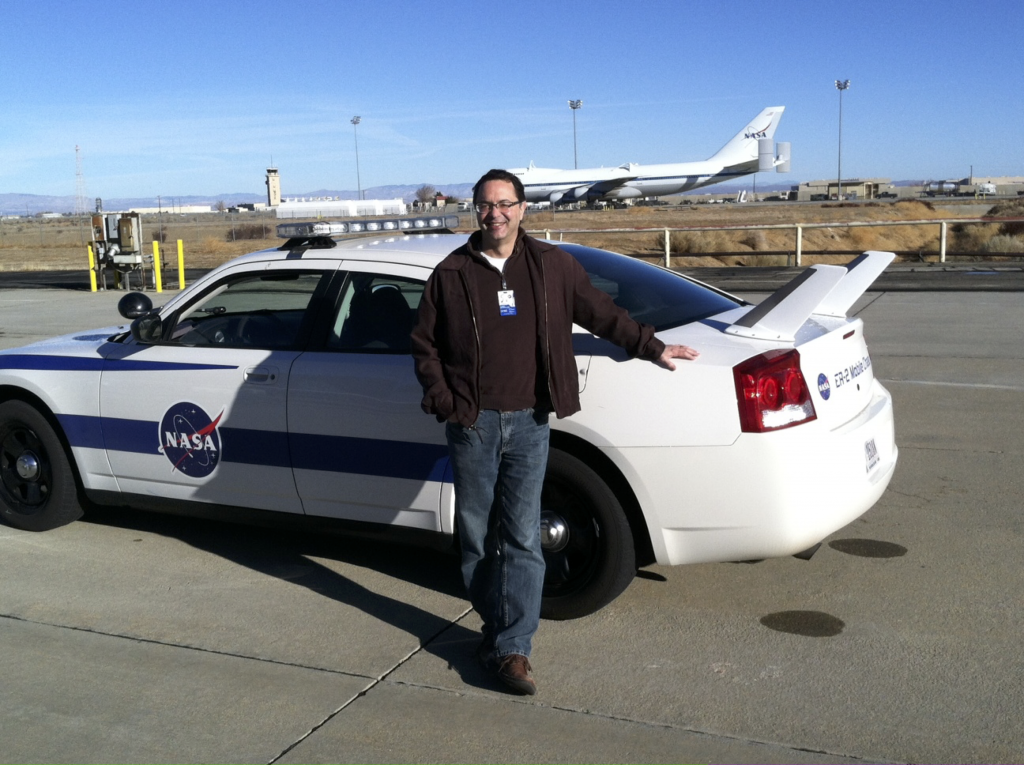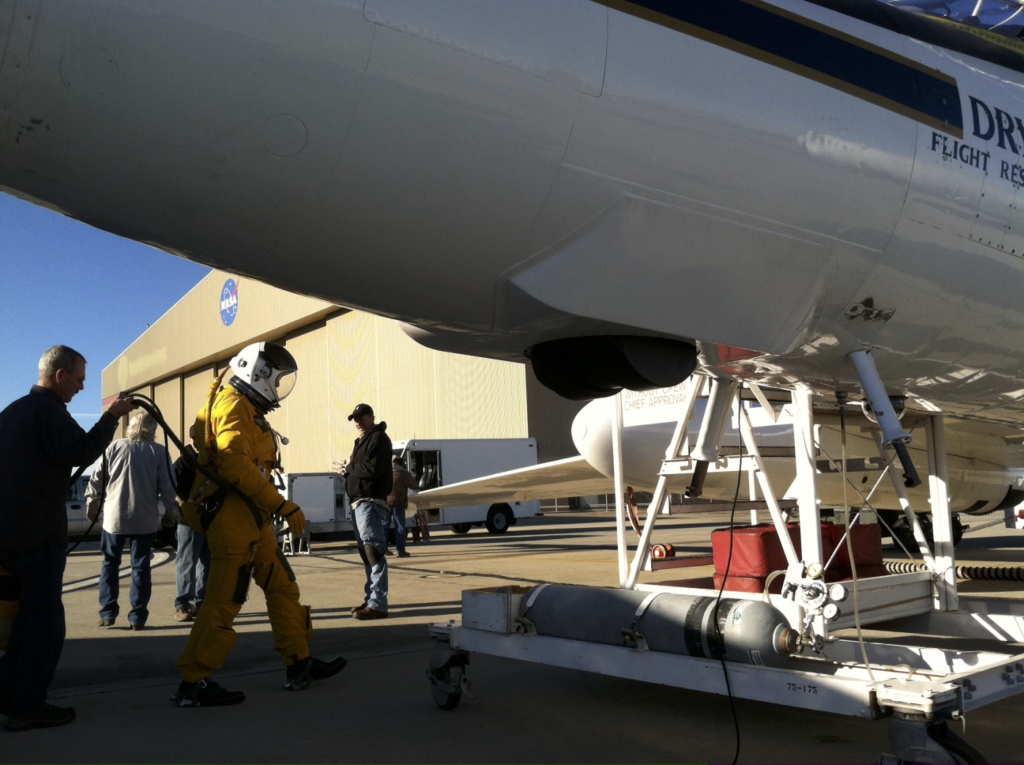
The Multi-Angle Imager for Aerosols (MAIA) was selected for launch by NASA under its Earth Venture program and is scheduled for launch in 2022. Its mission is to combine MAIA measurements with a chemical transport model and population health records to better understand the connections between aerosol pollutants and health problems such as adverse birth outcomes, cardiovascular and respiratory diseases, and premature deaths. You can learn more about MAIA at the official MAIA website hosted at JPL.
The MAIA satellite instrument is a high-resolution, multi-spectral, multi-angle, polarimetric imaging system. Multi-angle imaging is had using a two-axis gimbal, which provides along-track and cross-track pointing capabilities. The animation below (credit JPL) demonstrates MAIA’s sampling strategy over the LA Primary Target Area – one of a dozen large cities designated as Primary Target Areas.
Technology demonstration for MAIA was demonstrated as part of the Airborne Multiangle SpectroPolarimetric Imager (AirMSPI) program at JPL. Our group helped the AirMSPI team in various field campaigns, including SEAC4RS and PODEX. At times, this can be a lot of fun and scary as shown in the
with Prof. Di Girolamo in the NASA chase car. The driver of the chase car is also a pilot and is feeding the ER-2 pilot landing information, while the rest of us in the car are getting ready to jump out of the car just before the ER-2 stops so that we can run out and grab both wings so that the plane doesn’t tilt over. (no kidding).


Like MISR, Prof. Di Girolamo is a Co-I of the MAIA mission. Our group’s responsibility to the MAIA mission is to develop the MAIA cloud detection algorithm and to help ensure that the assessment of air pollutants on human health properly accounts for cloud-aerosol co-variability.
Acknowledgements
The MAIA project is supported by the Jet Propulsion Laboratory under contract with NASA. The publications below on aerosols include support from other contract under NASA or NSF and are listed int he acknowledgement section of the publication.
Peer-reviewed publications on aerosols
Fromm, M., D. Peterson, and L. Di Girolamo, 2019: The primary convective pathway for observed wildfire emissions in the upper troposphere and lower stratosphere: a targeted reinterpretation. J. Geophys. Res. Atmos., 124. https://doi.ord/10.1029/2019JD031006.
Chowdhury, S., S. Dey, S. Guttikunda, A. Pillarisetti, K.R. Smith, and L. Di Girolamo, 2019: Indian air quality standard is achievable by completely mitigating emissions from household sources alone. Proceed. Nat. Acad. Sci., doi:10.1073/pnas.1900888116.
Chowdhury, S., S. Dey, L. Di Girolamo, K.R. Smith, A. Pillarisetti, and A. Lypapustin, 2019: Tracking ambient PM2.5 build-up in Delhi NCT during the dry season over 16 years using a high-resolution (1 km) satellite aerosol dataset. Atmos. Environ. 204, 142-150, doi:10.1016/j.atmosenv.2019.02.029.
Diner, D.J., et al., 2018: Advances in multiangle satellite remote sensing of speciated airborne particulate matter and association with adverse health effects: from MISR to MAIA. J. Appl. Remote Sens. 12(4), 042603, doi: 10.1117/1.JRS.12.042603.
Zhao, G., L. Di Girolamo, D.J. Diner, C.J. Bruegge, K. Mueller, and D.L. Wu, 2016: Regional changes in Earth’s color and texture as observed from space over a 15-year period. IEEE Trans. Geosci. Remote Sens.,54(7), 4240-4249, doi:10.1109/TGRS.2016.2538723.
Yu, C., L. Di Girolamo, L. Chen, X. Zhang, Y. Liu, 2014: Statistical evaluation of the feasibility of satellite-retrieved cloud parameters as indicators of PM2.5 levels. J. Exposure Sci. Environ. Epidemiol., doi:10.1038/jes.2014.49.
Rauber, R.M., G. Zhao, L. Di Girolamo, and M. Colon-Robles, 2013: Aerosol size distribution and optical property variability near Caribbean trade cumulus clouds – effects of humidity and cloud processing as determined from aircraft measurements. J. Atmos. Sci., 70, 3063-3083.
Reid, J.S., E.J. Hyer, R. Johnson, B.N. Holben, J. Zhang, J.R. Campbell, S.A. Christopher, L. Di Girolamo, L. Giglio, R.E. Holz, C. Kearney, J. Miettinen, E.A. Reid, F.J. Turk, J. Wang, P. Xian, R.J. Yokelson, G. Zhao, R. Balasubramanian, B.N. Chew, S. Janai, N. Lagrosas, P. Lestari, N.-H.Lin, M. Mahmud, B. Norris, A.X. Nguyen, N.T.K.Oahn, M. Oo, S. Salinas, and S.C. Liew, 2013: Observing and understanding the Southeast Asian aerosol system by remote sensing: An initial review and analysis for the Seven Southeast Asian Studies (7SEAS) program. Atmos. Res., 122, 403-468
Dey, S., L. Di Girolamo, A. van Donkelaar, S.N. Trapathi, T. Gupta, and M. Mohan, 2012: Variability of outdoor fine particulate (PM2.5) concentration in the Indian subcontinent: a remote sensing approach. Remote Sens. Environ., 127, 153-161.
Dey, S. and L. Di Girolamo, 2011: A decade of change in aerosol properties over the Indian Subcontinent. Geophys. Res. Lett., 38, L14811, doi:10.1029/2011GL048153.
Minor, H.A., R.M. Rauber, S. Goke, and L. Di Girolamo, 2011: Trade wind cloud evolution observed by polarization radar: relationship to giant condensation nuclei concentrations and cloud organization. J. Atmos. Sci., 68, 1075-1096.
Dey, S., L. Di Girolamo, G. Zhao, A.L. Jones, and G.M. McFarquhar, 2011: Satellite-observed relationships between aerosol and trade-wind cumulus cloud properties over the Indian Ocean. Geophys. Res. Lett., 38, L01804, doi:10.1029/2010GL045588.
Dey, S., and L. Di Girolamo, 2010: A climatology of aerosol optical and microphysical properties over the Indian Subcontinent from nine years (2000-2008) of Multiangle Imaging SpectroRadiometer (MISR) data. J. Geophys. Res., 115, D15204,doi:10.1029/2009JD013395.
Tackett, J.L., and L. Di Girolamo, 2009: Enhanced aerosol backscatter adjacent to tropical trade wind clouds revealed by satellite-based lidar. Geophys. Res. Lett., 36, L14804, doi:10.1029/2009GL039264.
Zhao, G., L. Di Girolamo, S. Dey, A.L. Jones, and M. Bull, 2009: Examination of direct cumulus contamination on MISR-retrieved aerosol optical depth and angstrom coefficient over ocean. Geophys. Res. Lett., 36, L13811, doi:10.1029/2009GL038549.
Yang, Y., and L. Di Girolamo, 2008: Impacts of 3-D radiative transfer effects on satellite cloud detection and their consequences on cloud fraction and aerosol optical depth retrievals. J. Geophys. Res., 113, D04213, doi:10.1029/2007JD009095. (Ogura Award)
Rauber, R.M., B. Stevens, H.T. Ochs, C. Knight, B.A. Albrecht, A.M. Blyth, C.W. Fairall, J.B. Jensen, S. G. Lasher-Trapp, O. L. Mayol-Bracero, G. Vali, J. R. Anderson, B. A. Baker, A. R. Bandy, E. Burnet, J.-L. Brenguier, W. A. Brewer, P. R. A. Brown, P. Chuang, W. R. Cotton, L. Di Girolamo, B. Geerts, H. Gerber, S. Göke, L. Gomes, B. G. Heikes, J. G. Hudson, P. Kollias, R. P. Lawson, S. K. Krueger, D. H. Lenschow, L. Nuijens, D. W. O’Sullivan, R. A. Rilling, D. C. Rogers, A. P. Siebesma, E. Snodgrass, J. L. Stith, D. C. Thornton, S. Tucker, C. H. Twohy, and P. Zuidema, 2007: Rain In shallow Cumulus over the Ocean – The RICO campaign. Bull. Amer. Meteor. Soc., 88, 1912–1937.
Rauber, R.M., B. Stevens, H.T. Ochs, C. Knight, B.A. Albrecht, A.M. Blyth, C.W. Fairall, J.B. Jensen, S. G. Lasher-Trapp, O. L. Mayol-Bracero, G. Vali, J. R. Anderson, B. A. Baker, A. R. Bandy, E. Burnet, J.-L. Brenguier, W. A. Brewer, P. R. A. Brown, P. Chuang, W. R. Cotton, L. Di Girolamo, B. Geerts, H. Gerber, S. Göke, L. Gomes, B. G. Heikes, J. G. Hudson, P. Kollias, R. P. Lawson, S. K. Krueger, D. H. Lenschow, L. Nuijens, D. W. O’Sullivan, R. A. Rilling, D. C. Rogers, A. P. Siebesma, E. Snodgrass, J. L. Stith, D. C. Thornton, S. Tucker, C. H. Twohy, and P. Zuidema, 2007: A supplement to Rain In shallow Cumulus over the Ocean . Bull. Amer. Meteor. Soc., 88, S12–S18.
Frank, T.D., L. Di Girolamo, and S. Geegan, 2007: The spatial and temporal variability of aerosol optical depth in the Mojave Desert of southern California. Remote Sens. Environ.,107, 54-64.
Diner, D.J., L. Di Girolamo, and A. Nolin, 2007: Preface to the MISR Special Issue. Remote Sens. Environ.107, 1.
Di Girolamo, L., T. Bond, D. Bramer, D.J. Diner, F. Fettinger, R.A. Khan, J. Martonchick, M.V. Ramama, V. Ramanathan, and P. Rasch, 2004: Analysis of Multi-angle Imaging SpectroRadiometer (MISR) aerosol optical depths over greater India during winter 2001-2004. Geophys. Res. Lett., 31, L23115, doi:10.1029/2004GL021273.
McFarquhar, G.M., S. Platnick, L. Di Girolamo, H. Wang, G. Wind, and G. Zhao, 2004: Remotely sensed observations of aerosol indirect and semi-direct effects over the Indian ocean. Geophys. Res. Lett., 31, L21105, doi:10.1029/2004GL020412.
